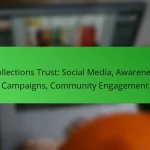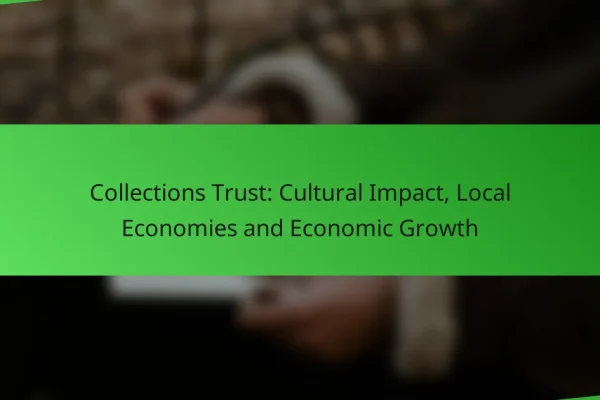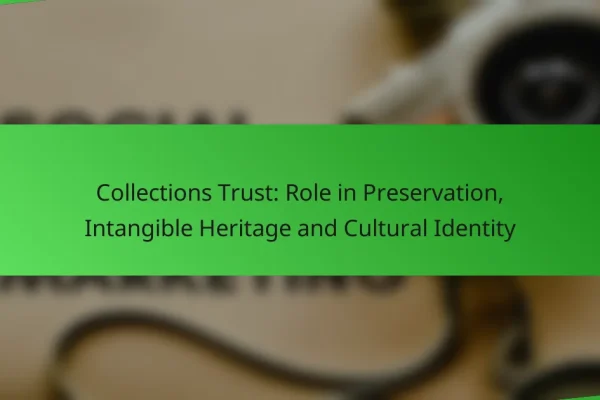How does Collections Trust benefit cultural heritage in the UK?
Collections Trust plays a vital role in enhancing cultural heritage in the UK by providing guidance and resources for the management and preservation of collections. This organization helps institutions ensure that artifacts are maintained, accessible, and educationally valuable for future generations.
Preservation of artifacts
The preservation of artifacts is a primary focus of Collections Trust, which offers best practices and standards for conservation. By promoting proper storage, handling, and documentation, they help institutions protect items from deterioration and loss. This includes guidelines for climate control, pest management, and restoration techniques.
Institutions can benefit from training programs and resources that teach staff how to care for collections effectively. Regular assessments and condition reports are encouraged to identify potential risks and implement preventive measures.
Enhancement of public access
Collections Trust enhances public access to cultural heritage by encouraging the digitization of collections and the development of online platforms. This allows a wider audience to engage with artifacts that may not be physically accessible, thus broadening the reach of cultural institutions.
By providing tools and frameworks for creating user-friendly online catalogs, Collections Trust helps institutions improve their visibility and attract diverse audiences. This can lead to increased visitor numbers and community engagement with local heritage.
Promotion of cultural education
Promoting cultural education is another key benefit of Collections Trust, as it supports educational programs that utilize collections for learning. By collaborating with schools and educational organizations, they help create resources that align with curriculum standards, making heritage relevant and engaging for students.
Workshops, exhibitions, and outreach initiatives are encouraged to foster a deeper understanding of cultural heritage. Institutions are advised to develop partnerships with local communities to create programs that resonate with diverse audiences, ensuring that cultural education is inclusive and impactful.
What are the key principles of Collections Trust?
Collections Trust is centered around principles that ensure effective management and stewardship of cultural heritage collections. Key principles include accountability, transparency, and the ethical handling of collections to foster public trust and engagement.
Accountability in collection management
Accountability in collection management involves ensuring that all actions taken regarding cultural assets are responsible and justifiable. Institutions must establish clear policies and procedures that outline roles and responsibilities, making it easier to track decisions and actions related to collections.
For example, museums should maintain detailed records of acquisitions, loans, and deaccessions, ensuring that all transactions are documented and can be audited. This not only protects the institution but also builds trust with stakeholders and the public.
Transparency in processes
Transparency in processes refers to the openness of an institution’s operations concerning its collections. This includes making information about collection management practices accessible to the public and stakeholders, which can enhance trust and engagement.
Institutions can achieve transparency by publishing collection policies, providing access to collection databases, and openly communicating about the provenance and significance of items. Regularly updating stakeholders about changes in policies or practices is also crucial for maintaining transparency.
How can organizations implement Collections Trust standards?
Organizations can implement Collections Trust standards by establishing clear policies and procedures that align with these guidelines. This involves assessing current practices, identifying gaps, and making necessary adjustments to enhance the management of cultural heritage collections.
Adopting best practices
Adopting best practices involves integrating proven methods into the management of collections. Organizations should regularly review and update their policies to reflect current standards and innovations in the field. For example, utilizing digital cataloging systems can improve accessibility and preservation.
It’s essential to create a framework that supports transparency and accountability in collections management. This can include regular audits and evaluations to ensure compliance with Collections Trust standards, fostering a culture of continuous improvement.
Training staff on guidelines
Training staff on Collections Trust guidelines is crucial for effective implementation. Organizations should develop comprehensive training programs that cover the principles and practices outlined in the standards. This can include workshops, online courses, or hands-on training sessions.
Regular refresher courses can help maintain staff awareness and engagement with the guidelines. Encouraging staff to participate in professional development opportunities can also enhance their skills and knowledge, ultimately benefiting the organization’s collections management efforts.
What are the challenges faced in implementing Collections Trust?
Implementing Collections Trust involves several challenges that can hinder effective management of cultural heritage. Key issues include funding limitations and resistance to change within organizations.
Funding limitations
Funding limitations are a significant barrier to establishing a robust Collections Trust. Many cultural institutions operate on tight budgets, making it difficult to allocate resources for necessary technology and training.
Organizations may need to explore alternative funding sources, such as grants or partnerships, to support their Collections Trust initiatives. Engaging with local businesses or community organizations can also provide additional financial support.
Resistance to change
Resistance to change often arises when implementing new systems or practices related to Collections Trust. Staff may be accustomed to traditional methods and hesitant to adopt new technologies or processes.
To overcome this resistance, it is essential to involve staff in the planning stages and provide comprehensive training. Highlighting the benefits of Collections Trust, such as improved access to collections and enhanced preservation efforts, can help foster a more accepting environment.
How does Collections Trust support community engagement?
Collections Trust enhances community engagement by fostering connections between cultural institutions and local communities. Through various initiatives, it encourages collaboration, participation, and shared ownership of cultural heritage.
Facilitating local partnerships
Collections Trust plays a crucial role in establishing partnerships between museums, galleries, and community organizations. These collaborations often involve joint projects that reflect local history and culture, allowing institutions to better serve their audiences.
For example, a museum might partner with a local school to develop educational programs that highlight regional heritage. Such partnerships not only enrich the community’s understanding of its cultural assets but also strengthen the institution’s relevance and support.
Encouraging volunteer involvement
Volunteer programs are vital for engaging community members in cultural heritage initiatives. Collections Trust supports institutions in creating meaningful volunteer opportunities that allow individuals to contribute their skills and time.
By offering training and resources, organizations can effectively recruit and retain volunteers. This involvement can range from assisting in exhibitions to participating in preservation efforts, fostering a sense of ownership and pride within the community.
What role do digital technologies play in Collections Trust?
Digital technologies are essential for enhancing Collections Trust by improving access, preservation, and engagement with cultural heritage. They enable institutions to manage collections more effectively and share them with a wider audience through various online platforms.
Online collections databases
Online collections databases serve as centralized repositories for cultural artifacts, allowing institutions to catalog and display their collections digitally. These databases can include detailed descriptions, images, and provenance information, making it easier for researchers and the public to explore cultural heritage.
When creating an online database, institutions should consider user-friendly interfaces and robust search functionalities. Utilizing established standards like Dublin Core can enhance interoperability and ensure that data is easily accessible across different platforms.
Virtual exhibitions
Virtual exhibitions provide an innovative way to showcase collections without the limitations of physical space. These online displays can include multimedia elements such as videos, audio guides, and interactive features that enhance the visitor experience.
To create effective virtual exhibitions, institutions should focus on storytelling and thematic organization. Engaging narratives can draw visitors in, while high-quality visuals and intuitive navigation can keep them interested. Regular updates and new content can also encourage repeat visits and sustained engagement.
What are the future trends in Collections Trust for cultural heritage?
Future trends in Collections Trust for cultural heritage focus on increased digitalization, enhanced accessibility, and collaborative frameworks. Institutions are prioritizing the use of technology to improve collection management and engage broader audiences.
Increased Digitalization
As technology advances, cultural heritage institutions are adopting digital tools to manage collections more efficiently. This includes the use of databases, digital asset management systems, and online platforms that allow for better inventory tracking and public access.
For example, museums are increasingly digitizing their collections to create virtual exhibits, which can reach global audiences. This trend not only preserves artifacts but also enhances educational opportunities for diverse populations.
Enhanced Accessibility
Accessibility is becoming a key focus in Collections Trust, with efforts to ensure that cultural heritage is available to all, including those with disabilities. This includes creating user-friendly online interfaces and providing materials in various formats.
Institutions are also exploring partnerships with tech companies to develop applications that facilitate access to collections. These initiatives aim to break down barriers and encourage wider participation in cultural heritage activities.
Collaborative Frameworks
Collaboration among cultural institutions is on the rise, fostering shared resources and knowledge. This trend involves joint projects, shared databases, and cooperative funding initiatives that enhance the sustainability of collections management.
For instance, regional heritage organizations may collaborate to create a unified digital platform that showcases collections from multiple institutions. This approach not only maximizes resources but also enriches the cultural narrative presented to the public.











